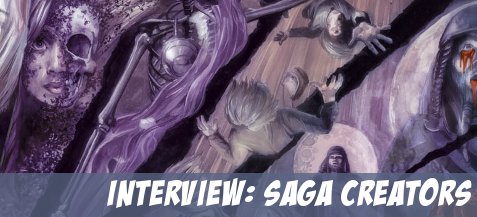JAN 24, 2011 – From the publisher of MOUSE GUARD, THE DARK CRYSTAL, and FRAGGLEROCK comes SAGA, an epic Viking tale of feuding kingdoms of Scandinavia around the 13th century.
Watch for Part II of SAGA coverage on Wednesday when I share my interview with artist J.K. Woodward who not only discusses SAGA but also his work on FALLEN ANGEL (IDW) and other insights about his process.
ARCHAIA: King Harald of Vestfold lives to complete one mission: to unite the feuding kingdoms and tribes of Scandinavia’s North Sea into a single kingdom, the North Way (Norway). His neighbors prepare to face him, and defend their freedom.
Behind the scenes, men and women from all walks of life, thrown together by blood ties, sexual intrigue, or oaths of loyalty prepare to weather the coming storm—or to take part in it and carve out their place in history. For them, all things of this world must die—but glory is forever.
CREATOR: BRIAN GOTTESMAN

As a lawyer by day and writer by night, how do you balance the different aspects? Do you keep a daily schedule or do you do your writing during a sabbatical?
I don’t really have a set writing schedule. I’ve never really had the kind of schedule that lends itself to a regular, set time for writing. I have been writing creative fiction for a while and always made time for it as I was able. I wrote my first (still unpublished) novel, The King of Zion, in bits and pieces during college and law school. I’m currently writing another, Before the World Falls, that’s set in roughly the same period and involves some of the same historical figures as Saga. The Saga materials themselves were drafted over time – when I have a free moment I think about the characters, storylines, etc., and jot down some notes, then later write more seriously, usually in the evenings or on weekends.
That’s a good question, and not one that’s easy to answer. Most of the Icelandic sagas (including the ones Saga draws from) were written between 1200 and 1400, but they describe events hundreds of years previous. There’s a lot of dispute among scholars about the extent to which they reflect “real” history, or a sort of mythologized history. My view is that they are largely reliable reflections of oral history, but that over time mythologized elements got mixed in, especially in the family trees (a surprisingly large number of early Icelandic settlers managed to be descended from royalty, for instance).
If you’re asking about the stories that the Norse had about their gods and mythic heroes, that’s a much trickier question. Pre-Christian Scandinavian religion didn’t leave a lot of written records, and the sources that did write about it (mostly Christian priests) were mostly hostile. The Norse didn’t have anything like a uniform Bible containing their myths and religious beliefs. Even to speak of a “Norse religion” or “Norse mythology” is misleading because different regions, tribes and social groups probably focused their attentions on different gods and different stories. Norseman of the 9th century would probably have picked one or more gods to whom he gave his devotion. A warrior or a poet might prefer Odin, the god of battle and art, but a farmer might primarily worship a fertility god like Frey. The most popular god in most regions appears to have been Thor. But these different cults wouldn’t have been mutually exclusive. For example, Hilda Davidson wrote a book called The Road to Hel in which she catalogued five or six different belief systems about life after death, all of which seem to have coexisted in the same region and time period.Most of what we know about Norse religion and myth comes from two collections, the Poetic Edda (written in the mid 12th century) and the Prose Edda (written in the early 13th century), but these sources describe a religion or religions that had already been mostly dead for at least a century, so they have to be taken with a grain of salt. So there’s a lot of room to be creative, and to pick and choose the theories that best fit the story.
I think there’s a lot of misunderstanding and misinformation about the Viking Age. The image most people have of an early medieval Norseman is of a violent, ignorant savage. The truth is that there’s another side to Norse culture to which most people are never exposed – they were great artisans and technicians, master shipbuilders and navigators. They were well traveled – there were Norse colonists and merchants pretty much everywhere between the shores of Newfoundland and the steppes of southern Russia. They wrote some of the greatest literature Western civilization has ever produced, and some incredibly intricate and moving poetry. And they were very savvy lawmakers – a lot of the concepts we take for granted today, like trial by jury, came at least in part from Scandinavia. In some places they were pioneers of republican government – early Iceland had laws, a legislature and a court system but no king. So they may as a group have been warlike (though I’m not convinced they were exceptionally so) but they were also products of an extremely sophisticated and in some ways cosmopolitan culture.
Oh my God, I would never last for very long. I sometimes think it would be cool to be on a longship, navigating by the stars and sailing to unexplored lands, but let’s face it, I would be hypothermic and seasick probably within the first day. And I probably wouldn’t fare much better on land. We today are so pampered – even some of the very poorest people in a modern, Western, industrialized society have a higher standard of living than the upper class living in a place like 9th century Norway, in terms of availability of food, creature comforts, etc. Plus Norse culture was harsh and didn’t suffer fools gladly, and I’m sure I would very quickly piss off the wrong person and start a blood feud. But hopefully I would make some good friends in the process who would avenge me.I guess if I had to choose I would be a skald, or poet. In a mostly non-literate society, poetry was how people’s fame was spread. Writing a poem about someone was like giving them immortality, so a skald was highly prized and the skill to write that kind of poetry was seen as sort of a divine gift. In a way all the work I’ve done and will do on Saga is a tribute to some of the great characters I’ve come to know through the sagas and the poetry of the skalds – a way of giving them a renewed immortality with today’s audience.
What was the search like to get a fitting writer and artist team?
Both Marc Andreyko and J.K. Woodward were brought on board by Archaia Comics. Ara and I both had an opportunity to see work from a number of different artists and writers and ultimately we all decided on Marc and J.K. because of their love of the historical period and their understanding of the source materials. Both Marc and J.K. have been kind enough to involve me in many aspects of their creative processes, for which I’m grateful.
I don’t have a literary agent. I’ve been working for several years on this project with Ara Katz, a very capable producer and the driving force behind Saga’s development. Ara is the one who put together the deal with Archaia Comics to do the SAGA series and she is also spearheading the efforts to produce Saga as a television series.
CREATOR: ARA KATZ
What was your involvement in the project?
I worked with Brian to develop the story, first developing the arc of a TV series then later working with Marc Andreyko to further develop that and then set up the property at Archaia after we decided to publish a version of the story in graphic novel form first before looking to set up the series or film.
Was this historic time period something with which you were already familiar?
Not at all, so it’s been so interesting learning about this period of time from Brian and debunking so many of the myths that are commonly associated with Viking culture.
Will there be additional volumes?
We’re talking to Archaia about this.
Why does Archaia seem like the right home for SAGA?
They understood that SAGA depicted this world in a fresh way with a compelling aesthetic and character line up. They have such an eclectic library so it didn’t feel like we were just signing up with a typical genre publisher – they’ve depicted such interesting worlds in their library that it felt like a good fit. We loved the writers, illustrators and colorists they suggested and felt that it reflected a great understanding of how we wanted to bring the story to life.
PART II features an entire spotlight on SAGA’s artist, J.K. WOODWARD.

